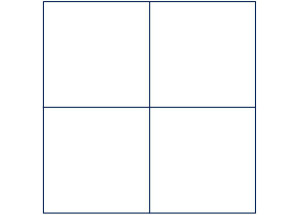Could I Change?
At what seemed like an important crossroads in my own life, when there was a clear sense of fluidity and freedom of choice, I found myself mapping out a simple framework to help clarify my options. This structure did not attempt to list and prioritize career choices or places to live, for example, but pointed to a more fundamental dichotomy between the forces of personal desire or will, and a sense of what was right at the level of universal values and personal convictions. I sketched a simple matrix to represent these two forces of power and values and called it The Polarity Grid. I immediately realized that at any moment I could locate myself in the Grid: I could identify a point on the Grid which represented my state of being. Clearly, my location in the Grid would change with a change in my state or condition, so I could move in the Grid. That simple fact opened up the possibility that if I could move in the Grid, then perhaps I could also move beyond the Grid.
What does the Polarity Grid look like?
Power and Polarity exist on a grid with the vertical axis representing positive and negative polarity and the horizontal axis representing power.
The plus and minus signs indicate that on the vertical axis, as we move above the midpoint positivity increases, and as we move below the midpoint, negativity increases. The horizontal axis shows that as we move to the right power increases; as we move to the left, power decreases.
Although we can easily understand ‘positive’ power when it is applied to a car or electric light, for example, ‘negative’ power in the Grid needs clarification. In human terms, we can see it as a diffusion of energy and loss of focus resulting in a diminishing effectiveness or a lack of impact. We can clarify this idea in the Grid by stating that on the horizontal axis, power increases as you move to the right of the neutral point, and weakness increases as you move to the left of the neutral point. With this particular meaning in mind we find that this simple structure allows us to explore fundamental questions such as Where am I in life? Where do I want to be? How can I change things which need changing?
The Four Quadrants
This gives four quadrants in the grid which are labelled Q1 Strong Negativity, Q2 Weak Negativity, Q3 Weak Positivity and Q4 Strong Positivity
 In our daily life we may find ourselves stuck, for example, in strong negativity, in Quadrant 1, but we would like to get to Quadrant 3 or 4 and live a more powerful and positive life. We can use the Grid like a map to find out where we are at a given moment and how we might get from one place to another. So far, however, this ‘map’ is clearly incomplete. As it stands the two axes could stretch to infinity, so if this structure is to be useful we need to give it a border.
In our daily life we may find ourselves stuck, for example, in strong negativity, in Quadrant 1, but we would like to get to Quadrant 3 or 4 and live a more powerful and positive life. We can use the Grid like a map to find out where we are at a given moment and how we might get from one place to another. So far, however, this ‘map’ is clearly incomplete. As it stands the two axes could stretch to infinity, so if this structure is to be useful we need to give it a border.
But having understood its structure and meaning, we do not need to clutter it up with unnecessary labels and symbols – and this gives us the basic Polarity Grid.

‘We animate the Grid with our own story, with hopes and aspirations, people and events, victories and defeats.’
We can all find ourselves in the Polarity Grid where our fixed attitudes and opinions and habitual behaviours mean that we move through a uniquely familiar landscape. But we can move in the Grid. We can envisage a different world for ourselves and others. We can also move beyond our Grid and gain a higher degree of freedom. Then we really begin to change. But first, we need to see our Grid.

